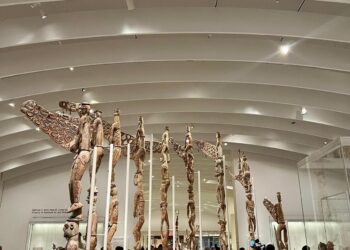After four years of closure, planning, and construction, the Michael C. Rockefeller Wing at the Metropolitan Museum of Art reopens on May 31. Completely reimagined across almost 40,000 square feet, the redesign is the work of architect Kulapat Yantrasast (WHY Architecture), in collaboration with Beyer Blinder Belle.
Three major geographies converge in the new wing: sub-Saharan Africa, the Indigenous Americas, and Oceania. But they don’t appear as fixed territories. They move along oblique lines that cut through materials, rituals, scars, and forms of resistance. The newly reimagined Michael C. Rockefeller Wing is entirely devoted to works once labeled as “primitive,” now finally recognized for their distinct cultural identities. A total of 1,726 pieces are on display—including statues, funerary poles, jewelry, masks, frescoes, paintings, photographs, and textiles—gathered through donations and acquisitions. These works now occupy a space that better reflects the growing understanding and respect for the traditions from which they originate.

In the African gallery, an architectural vault recalls the Great Mosque of Djenné. Five hundred works, dating from the 12th century to the present, are arranged in a space guided not by chronology but by memory. The monumental textiles of Abdoulaye Konaté stretch across entire walls, like ceremonial cloaks stitched with color and politics. In one corner, a series of documentary films by Sosena Solomon accompanies visitors with whispered voices: artisans, storytellers, mothers.
Roughly 700 objects are on view in the galleries dedicated to the Americas—ceramics, feathers, metals, codices. The Maya, Inca, Zapotec, and Caribbean cultures are not framed as vanished civilizations, but as living systems of thought. One gallery focuses entirely on Andean textiles, with close attention to technique, symbolic meaning, gender roles, and spiritual hierarchies.
The Oceania section is structured around a diagonal path that echoes the ancestral routes of Austronesian peoples. Asmat sculptures collected by Michael Rockefeller are displayed alongside contemporary works that reflect on cultural continuity and historical trauma. At the center is the ceremonial Kwoma ceiling, installed in a naturally lit room. Ritual and domestic objects, male and female expressions, coexist along the way—blurring the line between the sacred and the everyday.

“This isn’t just about putting objects on display,” says curator Alisa LaGamma. “It’s about letting them speak. And the voices we hear now are not those of collectors, art historians, or curators—they’re the voices of the artists and the communities these works come from.”
The museum is also a family story. The Rockefeller Wing traces its origins to Nelson Rockefeller—patron, politician—and his son Michael, who disappeared in New Guinea in 1961. Michael went there to collect, to learn, but also, in some way, to stay. His twin sister, Mary Rockefeller Morgan, now 87, has followed the wing’s transformation closely. “What I see today,” she said, “is my father’s dream. And Michael’s too”.

On opening day, May 31, the Met will turn into a gathering space. From noon to six, the courtyards will host performances, traditional dances, and dishes from the Queens Night Market inspired by precolonial cuisines. Artist Manny Vega will lead a collective action on the museum’s steps. For one day at least, art steps out of the vitrines. It speaks. It moves. It sounds.












